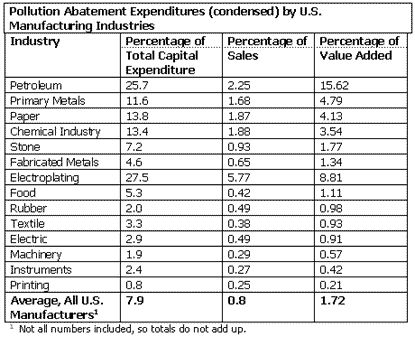Environmental costs and competitiveness — Part 2

Highlights from a 1994 OTA report on pollution-control spending are revealing
By David L. Russell
Global Environmental Operations Inc.
In a preceding article, this author discussed the point that the USA is spending more on environmental regulation than anywhere else in the world—at least U.S.$1,000 per family in 1990—for just battling water pollution and solid-waste pollution. The cost of air regulations has not been counted because of the widely differing standards and requirements and because many of the costs are imbedded in the cost of industrial development, and thus may be practically impossible to segregate and identify as individual cost elements.
The 1994 Office of Technology Assessment (sadly now disbanded) issued a report on the cost of U.S. regulations. According to the report entitled "Industry, Technology and the Environment" (ISBN 0-17-043023-2), the cost of pollution abatement and control for 1991 was about 2.3% of the U.S. GNP and climbing. But here's where it gets interesting.
The total amount spent on pollution control in 1991 was about $91.456 billion. Of that, business spent about 53%, or $48.259 billion. Further breaking this last figure down a couple of steps makes for even more interest.

Because motor vehicles were not separated but aggregated, the category is not included in the totals. Were it counted, the numbers and percentages for each category would be about 13.5% less.
The point is that U.S. business accounts for about 50% of the money spent on environmental control. When this is expressed as a percentage of total capital expenditures, the cost paid by U.S. firms is between 27.5% and 0. 8%, depending upon the industry, as shown in Table 7-2 of the OTA report and reproduced below.

The investment varies from industry to industry. U.S. industry pays an "overhead," on average, of about 7.9% for pollution-control compliance. In select industries, the investment for environmental control is between 11.6% and 25.7% of the total capital investment!
These costs were incurred before in 1991, before the heavy expenditures for cleanup of leaking underground storage tanks, or for compliance with Title V of the Clean Air Act. The need to comply with these regulations has further increased the costs.
Pollution control is expensive. I just thought that you might want to know how expensive.
About the author: David L. Russell is a PE and a principal of Global Environmental Operations, Inc., 4642 Warrior Trail, SW, Lilburn, GA 30047. Tel: 770-923-4408. Fax: 770-781-8004.
